Portraits in Courage Home Page
 The "Portraits in Courage"
program was developed to highlight the honor, valor, devotion and
selfless sacrifice of America's Airmen
The "Portraits in Courage"
program was developed to highlight the honor, valor, devotion and
selfless sacrifice of America's Airmen.
|
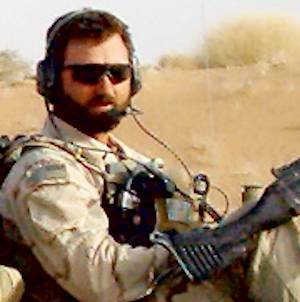
|
Master
Sergeant Michael West is a Combat Controller qualified and very
experienced in Joint Terminal Attack Control (JTAC) and Close Air
Support (CAS), In September, 2006, he was attached to one of several
Army Special Forces /earns operating near Kandahar, Afghanistan.
Sergeant West's team
leader wanted to occupy a dominant hill that offered a commanding view
of the surrounding areas. As another Coalition team pushed towards the
hill, they came under heavy attack and lost radio communications
Sergeant West had been monitoring the frequency and took over. He
positively identified the friendly personnel and the enemy fighting
positions and called in close air support. He directed 6-1B bombers to
destroy several buildings where ACM were sheltered. He then cleared
several A-l0s for multiple strafing passes against enemy positions. He
simultaneously worked with a Predator Unmanned Aerial Vehicle (UAV)
overhead to scan for more targets. His efforts saved the lives of his
teammates and enable the team to seize the high ground.
His team was on a
reconnaissance mission supporting a larger Coalition forces offensive
designed to clear Panjaway Valley of all Anti-Coalition militants
(ACM). Intelligence estimated 800-1000 ACM in the district, threatening
Kandahar's security.
This opening
sequence would lead to a week-long battle for the valley and
surrounding terrain. During this time, Sergeant West and two of his
JTAC teammates were on the hill, working multiple aircraft,
orchestrated by Sergeant West's battlefield awareness and ingenuity for
dividing airspace and platforms. The air support included French,
British, Dutch, and American fighters, bombers, attack helicopters,
AC-130H gunships, and UAVs. In concert with their teams' ground
maneuvers, they tirelessly engaged the enemy with airpower until the
aircraft needed to refuel or rearm. Throughout the Coalition operation,
Sergeant West called in MEDEVACs, controlled resupply airdrops for
ammo, food, and water, and coordinated 130 CAS missions including 15
separate troops-in-contact missions.
The Coalition forces
achieved decisive victories throughout the district regaining control
of the area and killing an estimated 750 enemy combatants. Sergeant
West's masterful situational awareness and precise employment of
Intelligence, Surveillance and Reconnaissance and CAS assets were vital
to the battle's overall success. |
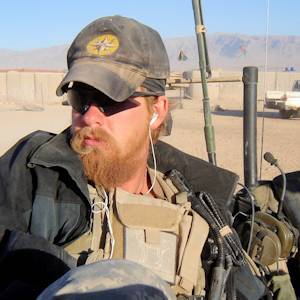
|
Staff
Sergeant Dean Conner is a Combat Controller and Joint Terminal Attack
Controller (JTAC), an expert at the direction and control of close air
support (CAS). In October 2007, Sergeant Conner was attached to one of
several Special Forces teams operating in a volatile region of
Afghanistan.
Sergeant
Conner’s team was conducting a routine vehicle patrol when his
convoy was ambushed. A rocket–propelled grenade struck his
vehicle and knocked him temporarily unconscious. After he recovered, he
returned fire with his M-240 machine gun, regained the advantage, and
prevented the convoy from being flanked. He also promptly requested CAS
to allow the remaining
vehicles to clear the zone.
Ten days later,
Sergeant Conner was once again performing JTAC duties when his Special
Forces team came under heavy fire. Sergeant Conner immediately
coordinated with the ground force commander and requested CAS. He
directed a flight of F-15Es onto their first target. As the F-15Es were
engaging the first target, Conner was hit in the abdomen by enemy
gunfire. In spite of his wounds, and refusing any pain medication that
could affect his mental acuity, he coordinated with the flight lead to
press their attacks on enemy combatants and protect his team. He
continued coordinating CAS missions for 45 minutes until his team was
safe and he was able to call for his own medical evacuation airlift.
For his gallant actions and devotion to duty, Sergeant Conner was awarded the Bronze Star Medal with Valor and the Purple Heart.
|
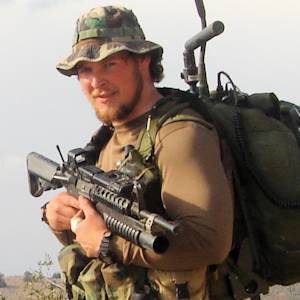
|
In spring 2007, Staff Sergeant Sean Harvell, a Combat Controller,
and his Special Forces team were the leading edge in the battle for
control of the fiercely contested Helmand Province in Afghanistan.
Months of intense fighting had taken a heavy toll on the team.
On July 25, 2007,
the team was tasked to patrol several miles up the Helmand River
valley, straight into a Taliban stronghold. The plan was to “move
to contact,” a tactic designed to force the enemy to reveal their
positions.
From the moment they
rolled into the first village, Sergeant Harvell’s team came under
heavy fire. The teams fought ferociously, killing dozens of enemy
fighters at close range. As darkness fell, an AC-130 gunship notified
Sergeant Harvell that the enemy had an elaborate series of trenches and
bunkers surrounding his position. As the battle intensified, Harvell
directed the gunship to decimate the enemy trench lines. The enemy made
frantic attempts to reinforce using motorcycles and trucks. Throughout
the night, Sergeant Harvell and his teammates eliminated the insurgents
with small arms fire and grenades.
Dangerously low on
ammunition, the team decided to make its way out and wait for
additional air support. During their movement, enemy fire erupted from
every direction. Once they made it back to their vehicles, Sergeant
Harvell manned his Humvee’s heavy weapon to suppress the
insurgents. At the same time, he coordinated air support. Minutes
later, A-10s and an AC-130 gunship arrived and Sergeant Harvell
directed precise, devastating attacks on the enemy positions.
|
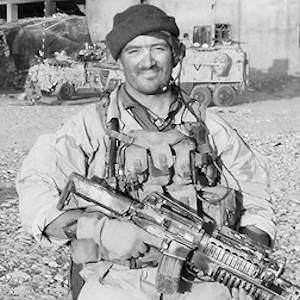
|
Master
Sergeant David Beals proved himself a hero through direction of precise
close air support (CAS) against a determined enemy in the remote
Afghanistan countryside during the winter of 2007.
On 4 December of
that year, Sergeant Beals was part of a 200-vehicle convoy conducting a
combat reconnaissance patrol through a route saturated with improvised
explosive devices (IEDs). After being attacked by an IED and small arms
fire, Sergeant Beals returned a heavy stream of fire from his M-240G
machine gun, enabling the convoy to continue on its path with zero
casualties.
When his convoy
again came under heavy fire from fortified positions the next morning,
he called for immediate CAS. For the next 15 hours, he coordinated
aircraft attack efforts. He deconflicted 150 friendly mortar calls,
providing integration of devastating air-to-ground attacks on the
enemy. Sergeant Beals controlled 20 CAS, missions releasing 19,000
pounds of ordnance that decimated the enemy and killed 87, including a
Taliban commander. During the same patrol, his team was ambushed by
direct enemy fire. With RPGs exploding in the air over their heads, he
engaged the enemy with his mounted weapon, killing five insurgents and
providing covering fire for vehicles caught in the kill zone. Finally,
he simultaneously controlled five attacks and utilized CAS to demolish
three compounds, killing 19 enemy attackers. His valiant efforts led to
the liberation of a village, ending a nine-month Taliban occupation.
For his actions during this patrol, Sergeant Beals was nominated for his third Bronze Star Medal with Valor. |
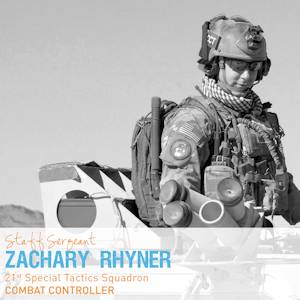
|
Then-Senior Airman Zachary Rhyner, a Combat Controller,
was deployed to Afghanistan, supporting Special Forces and Afghani
Commando units. In April ’08, during a 6 ½-hour airassault
raid to capture high-level terrorists, his team was attacked in a complex ambush.
His 10-man element
climbed a near-vertical, 60-foot cliff to reach the mountain top
objective, while sniper, machine-gun and rocket-propelled grenade fire
poured down. Within 15 minutes, enemy
forces killed one and wounded three teammates, including Sergeant
Rhyner. They were pinned down. Insurgent forces on the high ground
maneuvered 40 feet from the team. With disregard for his own
life, and while his left leg was being treated for a gunshot wound,
Sergeant Rhyner directed and controlled more than 50
“danger-close” air strikes and strafing runs against an
estimated 200 well-trained insurgent forces. The strafing runs were
within 100 to 200 meters, hammering the enemy forces with cannon fire,
Hellfire rockets, 500-pound bombs, and a 2,000-pound bomb. The blasts
showered the team with dirt and debris, but ultimately killed the enemy.
Sergeant Rhyner
repeatedly risked his life by placing himself between enemy forces and
wounded soldiers. Even while he was lowered by rope from the cliff,
Sergeant Rhyner continued to direct fire from aircraft overhead.
Additionally, he fired more than 100 rounds from his M-4 rifle to deter
the enemy’s advance and protect his team. His selfless actions
saved the lives of the entire team, eliminated 40 insurgents and
injured another 100.
For his actions, Sergeant Rhyner received the Air Force Cross and the Purple Heart. |
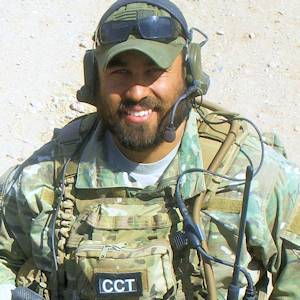
|
While assigned as a Combat Controller attached to a U.S. Army Special Forces Team, Staff Sergeant Robert Gutierrez
brought airpower to bear with precision and expertise, while he and his
teammates fought valiantly against a numerically superior enemy force
that commanded a significant tactical advantage from prepared fighting
positions on high urban terrain.
During an intense
firefight, Sergeant Gutierrez effectively engaged the enemy while
passing timely situation reports to Coalition aircraft. Suddenly, he
felt a pain in his left side and noticed a shooter on the rooftop to
his left. He swiftly retaliated with several rounds, subduing the enemy
sniper, but as he continued to return fire, the pain worsened. Sergeant
Gutierrez called for a medic as he slumped to the ground.
The medic began
treating Sergeant Gutierrez for a sucking chest wound and informed the
team leader that Sergeant Gutierrez would likely die without rapid
evacuation to medical care. Despite the wound, Sergeant Gutierrez
continued to coordinate close air support, repeatedly refusing to
remove his communications gear to allow for medical treatment. Battling
extreme pain and shortness of breath, Sergeant Gutierrez coordinated
with two A-10s to conduct a strafing pass on the rooftops adjacent to
the friendly position. While synchronizing an airstrike with the team's
exit plan, Sergeant Gutierrez donned his combat equipment and prepared
to move. Remarkably, Sergeant Gutierrez walked under his own power for
two kilometers to the landing zone, where he finally coordinated for a
medical evacuation helicopter.
Sergeant Gutierrez's
valorous actions not only helped save the lives of his teammates, but
also contributed to the subsequent death of the number two Taliban
leader in the region.
He was awarded the Air Force Cross from the Air Force Chief of Staff General Norton Schwartz.
|

|
Staff
Sergeant Yuri Miller deployed to Afghanistan for six months in February
2010 as a joint terminal attack controller attached to a U.S. special
operations unit supporting the Afghan National Army in the Baghdis
Province. On April 6, Sergeant Miller heroically fought enemy
insurgents during a harrowing 10-hour firefight.
After completing a
night reconnaissance mission, Sergeant Miller’s patrol came under
attack. Rocket-propelled grenades and heavy machine-gun fire from
a fortified compound engulfed the patrol. Despite deteriorating weather
conditions, small-arms fire, and rocket explosions, Sergeant Miller
calmly called for close air support and provided enemy locations to the
aircraft above.
The patrol had
suffered multiple casualties. In an effort to regain the offensive,
Sergeant Miller and other patrol members moved into the enemy compound,
engaging targets at close range. Fighting heroically, another teammate
was injured inside the compound. Sergeant Miller bravely exposed his
position and took out the enemy with his grenade launcher, allowing his
patrol to evacuate and treat their injured teammate.
Discovering an
extensive tunnel network, the commander realized the potential for
further enemy reinforcements was great and he quickly decided to
destroy the compound. Again under heavy fire, Sergeant Miller obtained
grid coordinates for each tunnel entrance while simultaneously radioing
an Air Force B-1 bomber into position for the attack.
Despite the
bomber’s attack, the team came under heavy fire from enemy
reinforcements while performing a battle damage assessment. Sergeant
Miller returned fire at the swarming insurgents, intermittently taking
pictures of the damage. The enemy continued to arrive – over 200
strong – bringing heavy fire along with them. Recognizing five
enemy locations, Sergeant Miller again called the B-1 in for an attack.
With Sergeant Miller’s precise coordinates, the bomber eliminated
the threat.
Sergeant
Miller’s courageous actions and his ability to control airpower
throughout this 10-hour engagement were decisive in killing more than
103 insurgents. Moreover, his valorous efforts singlehandedly saved the
lives of 40 fellow service members. For his heroic efforts, he received
the Bronze Star with Valor.
|
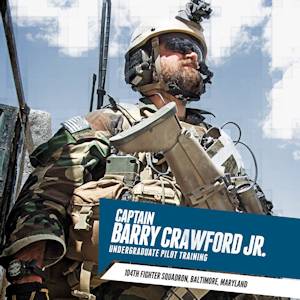
|
On
May 4, 2010, Captain Barry Crawford Jr., then a special tactics officer
assigned to the 23rd Expeditionary Special Tactics Squadron in Afghanistan, and a team of approximately 100 Army
Special Forces and Afghan commandos flew into the steep mountains of
Laghman Province. When the team landed in darkness, they heard
enemy chatter on their radios. Within 30 minutes of landing, they found
a substantial weapons cache inside the village. Captain Crawford also
received reports that armed enemy forces were maneuvering into fighting
position in the high ground.
As soon as the sun
came up, the coalition team came under heavy enemy fire from all sides
from over 100 fighters. The team was pinned down in the middle of the
village and had no choice but to run the gauntlet of enemy fire. Enemy
fighters used sniper and machine-gun fire to target the friendly
forces, and as insurgent forces closed in, three Afghan commandos were
gravely wounded and two others were killed. Recognizing that the
wounded Afghan soldiers would die without medical evacuation (medevac),
Captain Crawford ran into the open to guide a medevac helicopter to the
landing zone. Even though one of his radio antennas was shot off mere
inches from his face, without hesitation Captain Crawford ran across
the open terrain, engaging enemy positions with his rifle and calling
in AH-64 strafe attacks. This allowed the medevac team to move in
toward the casualties. As the casualties were being moved, the team was
once again pinned down by enemy forces that were threatening the
medevac landing zone. Stuck in an open, narrow valley with mountain
cliffs around them, the medevac helicopter took small arms fire and was
able to depart with only four of the five casualties. With the enemy
only 150 meters away at times, Captain Crawford once again called for
“danger-close” attacks from AH-64 and F-15E aircraft
overhead. In order to mark the enemy locations, he exposed himself to
enemy fire by running more into the open and engaged the enemy while
directing airstrikes. As a result, the medevac helicopter was able to
return and exfiltrate the last casualty. Throughout the harrowing 10
hour fight, Captain Crawford braved effective enemy fire and
consciously placed himself at grave risk on four occasions, all while
controlling over 33 aircraft and more than 40 airstrikes on a
well-trained and prepared enemy force. More than 80 insurgents were
killed during the engagement, including three high-ranking enemy
commanders.
For
his brave actions that day, Captain Crawford was awarded the Air Force
Cross, the second highest military decoration, behind the Medal of
Honor, that can be awarded to an Airman. |
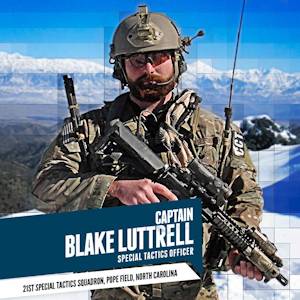
|
On January 9, 2012, Captain Blake Luttrell, a special tactics officer, and his element were conducting a helicopter assault in Afghanistan to capture a known insurgent and improvised explosive
device facilitator. Captain Luttrell’s element was ambushed by a
battle-hardened group of insurgents located 100 meters away. As Captain
Luttrell coordinated Army attack helicopters overhead, two Afghan
commandos were fatally shot. Moments later, another Afghan commando
received a fatal gunshot wound to the torso. In response, Captain
Luttrell and a teammate moved forward to pinpoint the enemy while
taking direct, accurate fire.
Captain Luttrell
then directed Army AH-64 Apache attack helicopters to suppress the
enemy cave complex, which they did with 100 rounds of 30-millimeter
shells and four thermobaric hellfire missiles.
Captain Luttrell and his element continued to maneuver under hostile
fire towards the fortified enemy position, and while clearing a nearby
building, his element was attacked by small arms
fire from a cave less than five feet away. As one Special Forces
Soldier moved around a corner to return fire, he was shot at
point-blank range, knocked to the ground, and was subsequently shot
again multiple times. Without hesitation, Captain Luttrell aggressively
engaged the enemy with his automatic weapon, deployed smoke into the
cave entrance, and courageously moved forward despite taking heavy
fire. While enemy rounds impacted all around him, he pulled the wounded
Soldier from the cave entrance and out of the line of fire.
Captain Luttrell
then administered lifesaving treatment to the wounded Soldier by
placing tourniquets on both legs. As he conducted first aid, his
teammates suppressed the threat, enabling the entire element to
maneuver out of the kill zone. Captain Luttrell then coordinated a show
of force with attack helicopters and established a helicopter landing
zone 200 meters south of the cave to evacuate the wounded Soldier. Once
the Soldier was successfully extracted, Captain Luttrell pushed all
friendly elements to a safe distance and controlled an Air Force B-1
bomber that dropped a 2,000-pound bomb, destroying the cave and ending
the enemy resistance.
Captain
Luttrell’s terminal attack control measures resulted in the
deaths of four enemy fighters. During the entire engagement,
Captain Luttrell remained under intense enemy fire; yet, epitomizing
true heroics, he never wavered during the heat of battle. For his
actions, he was awarded the Silver Star Medal. |
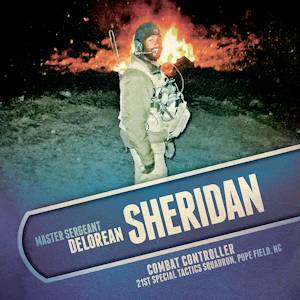
|
In March 2013, Technical Sergeant Delorean Sheridan
was completing a routine pre-brief for a Combat Control mission at his
deployed location in Wardak Province, Afghanistan. While his team
loaded gear into their vehicles, an Afghan National Police Officer
suddenly turned and opened fire with a truck-mounted machine gun merely
25 feet away. Simultaneously, 15 to 20 insurgents just outside the
village engaged the base with heavy machine gunfire.
With
rounds striking and killing his teammates surrounding him, Sergeant
Sheridan closed in on the gunman with a pistol and M-4 Rifle,
neutralizing the immediate threat with deadly accuracy. Still under
heavy attack from outside insurgents, Sergeant Sheridan exposed himself
to heavy machine gunfire three more times to drag his wounded teammates
out of the line of fire to a protected casualty collection point.
Once
his wounded teammates were pulled to safety, Sergeant Sheridan directed
close air support and surveillance aircraft to pinpoint, engage and
eliminate the additional insurgents. During these efforts, Sergeant
Sheridan also aided in assessing and moving his wounded teammates,
while directing the entrance and exit of six medical evacuation
helicopters.
Sergeant
Sheridan’s calmness and leadership in the face of danger helped saved
23 lives and allowed for the evacuation of his critically wounded
teammates. For these actions, Sergeant Sheridan was awarded the Silver
Star. |
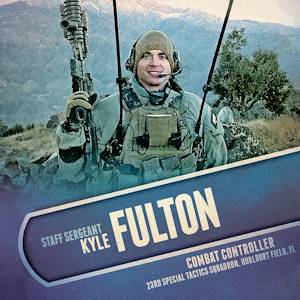
|
Deployed
in support of Operation Enduring Freedom, Staff Sergeant Kyle Fulton, a
Combat Controller, integrated airpower in support of coalition ground
forces at Jalalabad Air Force Base, Afghanistan on December 2, 2012.
Sergeant Fulton and his comrades were alerted to a nearby fire caused
by a large explosion. En route, Fulton established communications with
aircraft approaching the scene, identified friendly positions, and
coordinated aircraft attacks on insurgents maneuvering north of the
base’s perimeter wall.
Sergeant Fulton and
his team discovered that insurgent forces had explosively breached an
entry control point and were engaged in a furious firefight with
special operations forces defending the gap in the base’s
perimeter wall. Upon exiting the vehicle, Sergeant Fulton began taking
point-blank fire from insurgents hiding in the bed of a truck. He
returned fire with a teammate and killed two enemy fighters just before
insurgents attempted to storm the breach, supported by heavy machine
gun and rocket-propelled grenade fire. Intense fighting continued and
enemy grenades exploded less than 10 meters from Sergeant
Fulton’s position, showering the area with lethal bursts of
shrapnel.
As insurgent forces
detonated a suicide vest just 15 meters from Sergeant Fulton, he and a
teammate took cover behind a vehicle and engaged the enemy with 40mm
grenades, preventing their position from being overrun. Moments later,
an enemy grenade detonated close by, burying shrapnel in his leg.
Sergeant Fulton deftly applied two tourniquets to stem his bleeding
and, when two teammates shifted to cover his position, focused on
directing attack aircraft onto remaining enemy positions.
Sergeant Fulton and
his teammates prevented insurgent forces from storming Jalalabad Air
Base and allowed isolated friendly elements to evacuate their wounded.
For his heroic actions, Sergeant Fulton has been nominated for the
Bronze Star with Valor. |
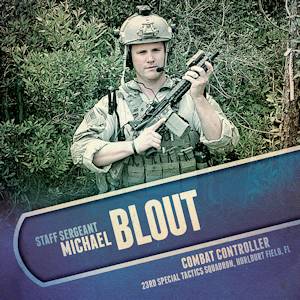
|
While
deployed in support of Operation Enduring Freedom, Combat Controller
Staff Sergeant Michael Blout, averted catastrophe during high-risk
combat operations on October 23, 2012. Sergeant Blout and his team
entered Chak Valley, a known hotbed of insurgent activity in
Afghanistan’s Wardak Province. The team split into two elements
to patrol through dense, jungle-like undergrowth where one of the
elements was ambushed and immediately took casualties.
As he approached a
small clearing in the foliage, the team’s chief warrant officer
suffered multiple gunshot wounds to his chest and legs. While enemy
forces poured unrelenting machine gun and rocket propelled grenades
from a nearby tree line, Sergeant Blout, without regard for his own
life, dashed into the clearing between his teammates and the enemy.
Sergeant Blout
suppressed enemy fighting positions with rifle fire, coordinated
AC-130W attacks along the enemy-held tree line, and called for an
urgent medical evacuation flight of helicopters to land on his
position. As the helicopters made their final approach, enemy fighters
increased their rate of fire. Sergeant Blout aborted the aircraft
before they could touch down and summoned three teammates to suppress
enemy fire sweeping the landing zone. Sergeant Blout then resumed the
evacuation of their mortally-wounded comrade as he summoned the
helicopters and coordinated an assault against an enemy machine gun
position.
Sergeant
Blout’s actions in the clearing prevented the loss of a coalition
aircraft and prevented the friendly position from being overrun. His
heroic actions earned him a Silver Star. |

|
|